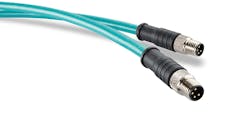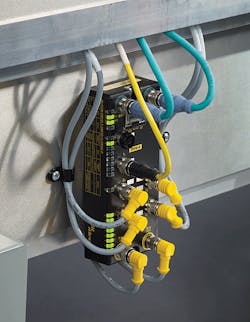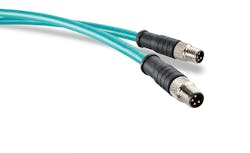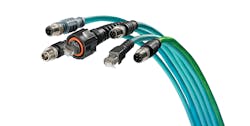This file type includes high resolution graphics and schematics when applicable.
The industrial connectivity landscape has changed dramatically over the last five years as industrial Ethernet has rapidly become the network of choice for demanding environments. And it wouldn’t have been possible without the right connectors.
Connectors form the critical link between cables carrying data and devices that record and communicate information. Here’s a quick exploration of the trends influencing connector design for the industrial Ethernet, from ever-smaller applications to ever-greater data-transmission speeds.
The Rise of Industrial Ethernet
Ethernet’s capabilities and benefits are convincing more companies to expand their use of it in industrial environments. They are putting Ethernet in place alongside of—or entirely replacing—industrial networks such as CANopen, DeviceNet, PROFIBUS, Foundation Fieldbus, and AS-interface. One reason is that industrial Ethernet networks handle significantly larger amounts of data at faster speeds than other networks. Worldwide, the global industrial Ethernet market should grow at an average rate of about 9.5% through 2019, according to Technavio, a market research firm.
Ethernet was first used in office environments. Over time, it was adapted for industrial settings, as companies wanted its faster data transfer speeds where it could do the most good, on the factory floor. It was quickly adopted by a range of industries and companies based on their long familiarity with it and its network design.
Moving to Ethernet is considered an easy change because most companies already have experts in it on staff. Existing IT departments operate the enterprise network, which means their technicians know how to troubleshoot traditional Ethernet. Understanding the ins and outs of traditional Ethernet is a good foundation but, in practice, the factory floor differs significantly from protected office environments. This complicates the move to industrial Ethernet.
Another factor affecting the decision to adopt industrial Ethernet is its ability to move more data at faster speeds than fieldbus networks. This makes it a top choice for high-end and data-heavy applications where bandwidth and bottlenecks can be issues, and holds true even for smaller, more compact applications.
These trends contribute to what could be the largest influence on Ethernet’s adoption – organizations wading into the Industrial Internet of Things (IIoT). Across manufacturing and process industries, companies are scrambling to add sensors, connecting them with a host of other plant equipment so managers can gather all the data they need to get a better real-time view of what’s happening on the floor. Ethernet is an ideal way to tie devices together. And, because it’s also used in offices, it lets managers, engineers, floor personnel, and supervisors access and view data from inside the factory and offices.
RJ45s in Industry
Although M12 is the recommended and preferred connector for industrial Ethernet, RJ45 connectors are still widely used for certain industrial applications such as:
• Inside panels and cabinets, one of the most common uses for RJ45 connectors in industry. These areas are protected from the environment, eliminating some concerns related to shock, vibration, and problems with water or oil.
• Quick access points for data, when some engineers want the flexibility to plug a laptop directly into the network on the factory floor. Because RJ45 connections are the same as a computer’s Ethernet port, maintaining them on the floor lets engineers quickly get the data they need without special adaptor cables.
Adapting Connectors for Industry
The most widely known Ethernet connectivity cordset is the RJ45 (8P8C connector). These connectors are the office gold standard because of their universal connectivity, ease of use, and quick connect/disconnect performance.
The IEC 60603-7 standard defines RJ45’s design and construction. There are RJ45 8-pin connectors for all current Ethernet categories, and the connectors can handle 2- and 4-pair wiring. Typical commercial RJ45s carry an IP20 rating.
Although RJ45s are the most widely used Ethernet connector, manufacturers began demanding more robust alternatives as they brought Ethernet onto the floor. The RJ45’s plastic ends and overall design are not ideal for harsh factory and plant environments, where shock, vibration, changing temperatures, and exposure to water and oil can damage connectors.
In response, engineers turned to M12 connectors, which were commonly used with sensors, and adapted them for the Ethernet. M12 Ethernet connectors feature a rugged overmold that encapsulates the connector’s components. The connectors carry a minimum of IP67-rated protection against dust and water ingress, as well as against vibrations and accidental impacts. M12 connectors are available as 4-pin D-Code, 8-pin A-Code or 8-pin X-Code. Data transfer speeds can be as high as 10 gigabits per second (Gbps), depending on the number of pairs and category of cable (much like RJ45 connectors).
In one case, a company that assembles conveyor segments and components into complete conveyor systems for customers had long used RJ45 connectors but continually saw them damaged during transit and assembly. Technicians had to re-terminate the RJ45s on site or, in extreme cases, replace the entire cable. Frustrated by the cost of time and resources lost to repair damaged RJ45s, the company explored their options before adopting M12 connectors. Switching to this rugged, overmolded design helped the company eliminate connector damage and cut its downtime for repairs and replacement.
Connectors Keep Pace with Ethernet Speeds
Another set of influences on connector design are the data transfer speeds possible with Ethernet.
Generally, connector technology follows advances in cables. For speeds up to 100 megabits per second (Mbps), or 100BASE-T, an Ethernet cable needs only two pairs of wires. For speeds up to 1 Gbps, or 1000BASE-T, four pairs are needed; it also takes four pairs to reach 10 Gbps or 10GBASE-T. So Ethernet can use both four- and eight-pin connectors, but the faster connections need the higher pin counts.
Industrial Ethernet connectors have continued to be updated to accommodate these ever-faster data transmissions. For example, what started as a 4-pin M12 turned into an 8-pin design. The most recent evolution has been the 8-pin M12 X-Code design, which can handle 10 Gbps Ethernet transmission speeds. To reach these speeds, the X-Code connector relies on advanced shielding and either CAT 6A or CAT 7 copper cables. And inside the connector, each of the four twisted pairs is shielded from one other. This prevents cross talk from hurting data quality, as well as unwanted signal coupling from one pair to another.
X-Code connector technology is experiencing an uptick in interest as more companies look for higher network speeds and more reliable, high-quality data transmissions. These demands will continue to drive advances in connector design, especially for data acquisition and vision systems and cameras.
Data bottlenecks slow operations but inconsistent or corrupted data can halt them altogether. Beyond end-users, manufacturers are taking advantage of this technology. For example, industrial manufacturers using cameras or vision systems in their application have begun installing M12 X-Code receptacles in their systems, to ensure the systems work at the designed speed with better performance and efficiency.
Data acquisition equipment manufacturers are another example. These organizations need to make sure their solutions reliably transmit data at the highest speeds possible without sacrificing data quality.
One manufacturer was already using M12 connectors with CAT 5e cable for its portable industrial solutions. But a recent project needed greater data handling capabilities. The manufacturer chose to upgrade to the most recent design advance in industrial connectivity—the M12 X-Code with CAT 6A cabling—to meet these demanding data handling requirements for its customer.
Smaller Devices, Smaller Connectors
Trends influencing automation device design are reaching the connector level, as well. One of these is the shrinking size of devices to accommodate ever-smaller application space. Advanced connectivity is required for success in these environments, which is creating demand for smaller devices that maintain advanced levels of communication. Automation component manufacturers are downsizing those devices, as well as the connectors used with them.
One example is seen with I/O modules and their associated connectors. OEMs are continually looking for ways to adapt their processes to new customer demands without needing to overhaul their operations, purchase new machines, or expand their footprints. Breakthroughs in technology have let automation component manufacturers shrink the size of I/O modules so OEMs can add advanced on-machine communications without reconfiguring processes. The smaller inputs and outputs on these blocks call for smaller connectors. That’s why some companies making automation components are moving from M12 connectors to the smaller M8 designs.
Before it was adapted for Ethernet, M8 connectors were favored for many industrial sensor applications and still remain popular today. The M8 design works well for industrial Ethernet because its pin spacing meets the performance requirements needed for the network and protocol. Performance depends on the location of twisted pairs in the connector. If they’re too far apart or too unevenly spaced, the chances of signal errors and loss increase. Because the M8 meets optimal performance specifications, and carries ingress protection for industrial applications, it can transfer data at up to 100 Mbps while fitting into smaller applications than the M12.
What’s Next?
As Ethernet continues its rapid expansion into industrial settings, manufacturers will adapt existing connectors for new uses and needs. Automation component suppliers have already begun customizing connectors for use with Ethernet.
One of the next influences on Ethernet connector design will involve Category 8 cable, which is anticipated to reach data speeds of 40 Gbps. With standards now being determined by the Telecommunications Infrastructure Assoc. (TIA), it’s likely this new cable will first spread to enterprise/office environments before demand grows for its increased speeds and data transfer capabilities in industry.
Another area of expansion will be in Ethernet for hazardous locations, where PROFIBUS, Foundation Fieldbus, and AS-I currently lead the pack. This trend is emerging as engineers and system integrators look to gain the faster speeds and advanced connectivity other industries are already enjoying with Ethernet.
When something goes wrong in a hazardous location, it can be catastrophic. Ethernet’s ability to connect all devices and report back can help engineers more closely monitor what’s happening in real time. Then they can make adjustments or maintenance as needed. Component manufacturers are already starting to reengineer existing connectors to meet the specific features required in these demanding environments.
Laura Schweitz, Connectivity Product Manager
Turck Inc., Minneapolis
Looking for parts? Go to SourceESB.
Ethernet Options
As Ethernet continues its rapid rise of adoption, manufacturers must decide which network protocol is the best for their plant and the communication needs of their applications. The first step is understanding Ethernet protocol options. Three of the most recognized are EtherNet/IP, Modbus TCP and PROFINET.
EtherNet/IP: This communication protocol is supported by Open DeviceNet Vendor Assoc. (ODVA), and implements the Common Industrial Protocol (CIP) onto the foundation of Ethernet. It was designed for industrial automation and process control applications, and includes tools to deploy standard Ethernet technology for industrial applications. For data exchange, the transmitting devices produce data and receiving devices consume that data. It uses a Transmission Control Protocol (TCP) layer in industrial settings. Typically, the TCP connects plant-wide communication to a company’s worldwide network through the Internet. It is also often used for data transfer, recording events and alarms, maintaining the program, supervisory control, and operator interface connectivity.
Modbus TCP: This variant of the Modbus family is intended for use with automation equipment. As a connection-based protocol, TCP opens and establishes a connection with a device to gather data. This data is received and combined with additional information before going to the IP layer, where it’s packaged and transmitted. It is typically used for Ethernet attachment to PLCs, I/O modules, and gateways to other fieldbuses or networks. It is simple and requires minimal hardware and cost to develop and support. It is also attractive for its interoperability with devices from different vendors.
PROFINET: This communications protocol is PROFIBUS and PROFINET International’s open industrial Ethernet standard for automation. It complements TCP/IP and IT standards with specific protocols, and works with existing fieldbus systems such as PROFIBUS, DeviceNet, and Interbus, without changing existing devices. PROFINET exchanges data via three communication channels. The TCP/IP channel works for configuration, parameterization, and acyclic read/write operations. The Real Time channel is ideal for cyclic data transfers and alarms. And the Isochronous Real Time channel handles high-speed motion control applications. All communications take place over the same cable, eliminating the need to invest in custom cabling. PROFINET has real-time performance capabilities that are ideal for factory and process automation—specifically automotive, logistics, and food and packaging applications. It is commonly used for synchronous I/O signal transmission and data-intensive parameter assignment, as well as controlling automation devices and high-speed operations.
This file type includes high resolution graphics and schematics when applicable.




